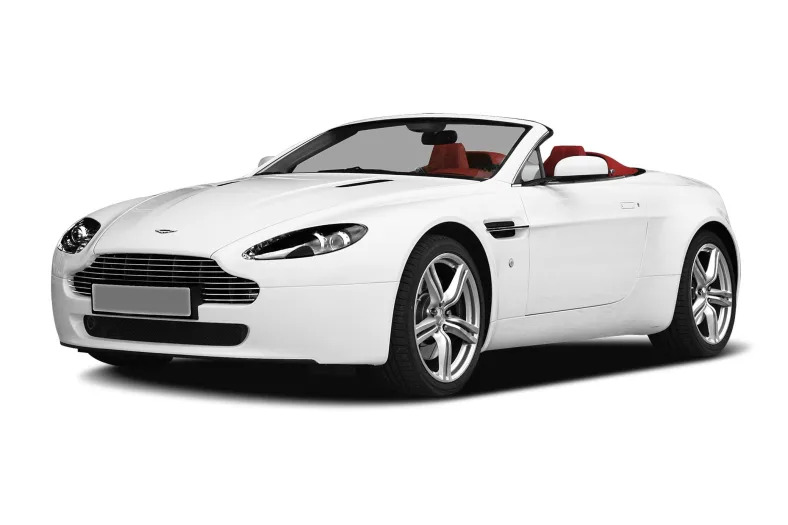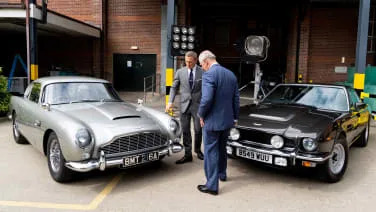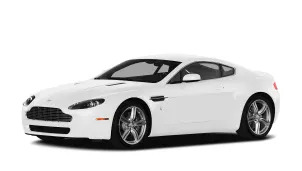Base 2dr Roadster
2009 Aston Martin V8 Vantage
Click above for a high-res gallery of the 2009 Aston Martin V8 Vantage. 2003 BMW M5. 2005 Lotus Elise. 2008 Aston Martin V8 Vantage. What do these three vehicles have in common? They all occupy a space in my dream garage. Sure, I could've added a few more fantasy slots for a Ferrari 250 GTO, a Land Rover 90 and everything in between, but the Bimmer, the Lotus and the Aston exemplify all I've ever wanted on four wheels: a powerful sedan, a competent track tool, and an elegant coupe. No matter the occasion, I'm covered. But there's a problem. While I've spent a fair amount of time in and around the Elise and M5, I've never had the opportunity to drive the Vantage. The Aston holds a spot on my lottery list on looks alone, so I arrived in San Francisco with a fair amount of trepidation. Will the V8 Vantage be everything I've dreamt about or will it be the automotive equivalent of meeting my hero? It's finally time to find out. %Gallery-28114% For 2009, Aston Martin took some sage advice from current Vantage owners: don't screw with the exterior. Aston's current lineup will undoubtedly go down in history as some of the most beautifully crafted machinery ever to roll on public roads, so there's no sense in messing with perfection or waxing poetic about the proportions. To that end, Aston is taking up the mantle formerly held by Porsche – a low-volume purveyor of specialty sports cars – leaving the exterior intact and only changing the design of the 20-spoke, 19-inch wheels. Some might call it lazy; we'll go with restrained. Any effort on Aston's part to refresh the Vantage on the cheap was immediately dispelled by the right people -- engineers. Instead of wasting manpower and capital on improving a timeless design, Aston's boffins took ye old 4.3-liter lump, bumped up the bore and increased the stroke to net 4735cc of stately displacement. Part of the increase was achieved by pressing thinner cylinder liners into the pre-machined aluminum block, while efficiency was boosted with new forged steel con-rods and cast aluminum pistons matched to a forged steel crankshaft with channels drilled into the counterweights to reduce rotating mass and improve cooling. Got all that? There's more. The dry sump lubrication system has been revised with a new casting and fitted with pick-up points mounted fore and aft of the sump, while the intake valves have been increased by 1mm with a modified manifold to match. All those tweaks bring output to 420 bhp and 347 pound-feet of torque, an increase of 11 and 15 percent, respectively. On paper, the extra 40 hp is only good for a 4.7-second sprint to 60 (.1 second off the outgoing model), but the 45 pound-foot increase in twist will impress the most. But the changes don't stop there. The rear-mounted, six-speed gearbox is still available in either manual or sequential flavors, but the clutch and flywheel have been modified …
Full Review
Click above for a high-res gallery of the 2009 Aston Martin V8 Vantage. 2003 BMW M5. 2005 Lotus Elise. 2008 Aston Martin V8 Vantage. What do these three vehicles have in common? They all occupy a space in my dream garage. Sure, I could've added a few more fantasy slots for a Ferrari 250 GTO, a Land Rover 90 and everything in between, but the Bimmer, the Lotus and the Aston exemplify all I've ever wanted on four wheels: a powerful sedan, a competent track tool, and an elegant coupe. No matter the occasion, I'm covered. But there's a problem. While I've spent a fair amount of time in and around the Elise and M5, I've never had the opportunity to drive the Vantage. The Aston holds a spot on my lottery list on looks alone, so I arrived in San Francisco with a fair amount of trepidation. Will the V8 Vantage be everything I've dreamt about or will it be the automotive equivalent of meeting my hero? It's finally time to find out. %Gallery-28114% For 2009, Aston Martin took some sage advice from current Vantage owners: don't screw with the exterior. Aston's current lineup will undoubtedly go down in history as some of the most beautifully crafted machinery ever to roll on public roads, so there's no sense in messing with perfection or waxing poetic about the proportions. To that end, Aston is taking up the mantle formerly held by Porsche – a low-volume purveyor of specialty sports cars – leaving the exterior intact and only changing the design of the 20-spoke, 19-inch wheels. Some might call it lazy; we'll go with restrained. Any effort on Aston's part to refresh the Vantage on the cheap was immediately dispelled by the right people -- engineers. Instead of wasting manpower and capital on improving a timeless design, Aston's boffins took ye old 4.3-liter lump, bumped up the bore and increased the stroke to net 4735cc of stately displacement. Part of the increase was achieved by pressing thinner cylinder liners into the pre-machined aluminum block, while efficiency was boosted with new forged steel con-rods and cast aluminum pistons matched to a forged steel crankshaft with channels drilled into the counterweights to reduce rotating mass and improve cooling. Got all that? There's more. The dry sump lubrication system has been revised with a new casting and fitted with pick-up points mounted fore and aft of the sump, while the intake valves have been increased by 1mm with a modified manifold to match. All those tweaks bring output to 420 bhp and 347 pound-feet of torque, an increase of 11 and 15 percent, respectively. On paper, the extra 40 hp is only good for a 4.7-second sprint to 60 (.1 second off the outgoing model), but the 45 pound-foot increase in twist will impress the most. But the changes don't stop there. The rear-mounted, six-speed gearbox is still available in either manual or sequential flavors, but the clutch and flywheel have been modified …
Hide Full Review
Hide Full Review
Retail Price
$130,400
MSRP / Window Sticker Price
| Engine | 4.7L V-8 |
| MPG | 12 City / 19 Hwy |
| Seating | 2 Passengers |
| Transmission | 6-spd man w/OD |
| Power | 420 @ 7000 rpm |
| Drivetrain | rear-wheel |
Smart Buy Program is powered by 






